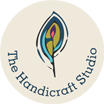The Handicraft Studio's Blog
Thangka Painting at Norbulingka Institute

Thangka Painting originated in Nepal in the 7th century and evolved into several different schools of painting, of which Norbulingka practices the "Menri" style. Menri uses bold colours, and focuses on a deity, surrounded by important events or people in his life. Historically, the art was used as a teaching & story telling tool.
The artist starts by stitching the canvas onto a wooden frame. The outline of the deity is first sketched in pencil and then in ink. Colourful paints are made using minerals & vegetable pigments, mixed with water. Even precious stones such as lapis lazuli are crushed to make colours like dark blue. Shading is done using different brush techniques. Then a pure gold paint is added. Finally, the thangka is framed in a precious brocade border.
Artists spend years learning & practicing the iconography, the proportions & paint mixtures to create an authentic piece. It takes upto 6 wks to make a 12x18" painting. Watch out for our next feature on wood painting!

